![]()
- History of development INDEX >>>
- Chronicle >>>
- Our Pride >>>
- Development story vol.1 >>>
- Development story vol.2 >>>
- Development story vol.3 >>>
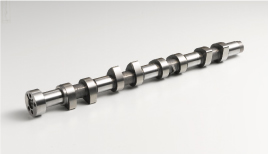
“We want you to make a special-purpose machine for cam shafts.” This is an unexpected inquiry KATAOKA received from an Indian in 1992. The ordering party was Cummins India Ltd. It was an Indian joint-venture company of Cummins Inc., a leading American engine manufacturer. “We are a manufacturer of special-purpose machines for piston rings. We haven’t made any machine for cam shafts. If we try to develop one, we may have a high financial risk. We’re sorry we’re not at all in a position to accept your order,” President Kataoka declined. His response stood to reason. The field of special-purpose machines for cam shafts had already been established with a leading German manufacturer on top. KATAOKA were familiar with piston rings, but had no technique or know-how of cam shafts. For KATAOKA, novel explosion in relation to cam shafts meant nothing other than a risk. In response to KATAOKA’s negative reply, President Nagpulka of Cummins India offered, “We’ll bear all development cost.” Before then, KATAOKA had received an inquiry for the development of a special-purpose machine for piston rings from Cummins India. At that time, President Kataoka visited India, and made presentation to him in person. However, for the reason of low investment efficiency, the inquiry failed to reach a contract. President Nagpulka, who had vividly remembered the contents of President Kataoka’s presentation, foresaw the technical and development abilities of KATAOKA, and requested President Kataoka for development. It seemed reckless on the surface. |
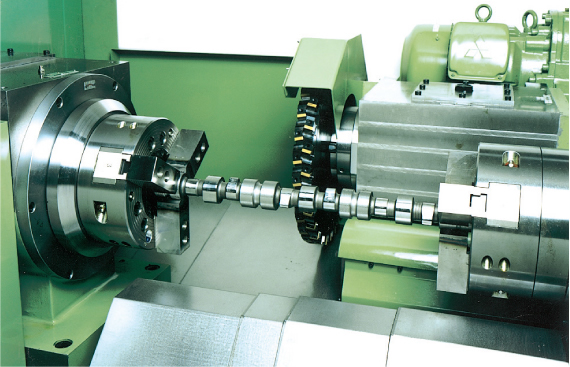 |
President Nagpulka was very logical. “You have a CNC machine for oval piston rings that elliptically processes the inside and outside diameters in the initial process. Cam shafts may also be of elliptical processing. If you apply your technique and know-how of that machine, you can develop a special-purpose machine for cam shafts, can’t you?” Certainly, piston rings and cam shafts are different only in curvature of elliptical processing. They can share the mechanism and software for trimming and grinding. “Now that Cummins has offered development funds to us, we have no alternative.” This pushed us to do a new challenge. At KATAOKA, however, there were no brains familiar with cam-shaft structure. President Kataoka observed a special-purpose machine for cam shafts that Cummins introduced from Germany and operated at its factory, received technical guidance on the machine there, and grasped its mechanical structure. Then, we fully utilized our CNC processing technique for piston rings, one of the strengths of ours. In 1994, we completed the development of a single-head cam shaft and cam milling machine (rough processing machine), “SCM-2NC.” |
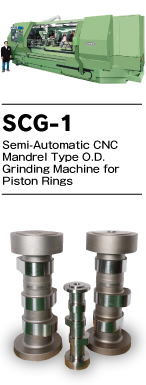 |
At the time of delivery of “SCM-2NC,” President Kataoka flied to India again also for on-site view. On the day before leaving India, he was invited to dinner by President Nagpulka of Cummins India. After expressing his consolidation and appreciation, Mr. Nagpulka offered another development to him, “Let’s develop a cam grinding machine next.” The cam grinding machine requires two core techniques. One is “hydrostatic spindle,” and the other is “hydrostatic slide.” The former is to float the wheel-revolving spindle after rough grinding, and the latter is to slide the spindle while controlling it in the hydraulically floated status. The technical level is much higher than that of the cam milling machine. Nevertheless, Cummins requested further for a combined machine with three functions (two wheel-heads and one milling head) consolidated into one machine. KATAOKA was not good at the “hydrostatic slid” technique. To add, the assignment was a combined machine. Its development was extremely difficult for us. It took us one year and a half to complete the development through trials and errors. In 2001, we developed “Full-Automatic CNC Combined Machine for Large-Sized Cam Shaft Journals and Cam Lobe Grinding and Keyway Milling SCG-1.” On this machine, cam shaft journals and cam lobes are ground with the hydrostatically controlled spindle, and grind-cutting of both grinding slide units are slid in the hydrostatically controlled status. That is, three processes can be processed on one machine. This is KATAOKA’s cam grinding machine. |
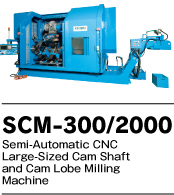 |
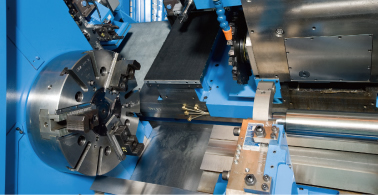 |
|
KATAOKA embodies customers’ needs in its development spirit with freewheeling idea free from ready-made ideas and cumulative techniques. To Cummins India, who had asked us to clear a challenge, i.e., the “development of special-purpose machines for cam shafts,” KATAOKA has delivered four models, including “SCM-2CN” and “SCG-1,” by 2010. This development has come to be a significant success. It also has invited immeasurable confidence in KATAOKA from overseas leading manufacturers and become a new strength of ours other than special-purpose machines for piston rings. Upon releasing the information of the newly developed special-purpose machines on our Web site, we received an approach from MTS SA, a leading French cam shaft manufacturer. MTS ordered us for a combined machine that could semi-automatically treat rough processing of cam lobes by milling before finish-grinding and semi-automatically treat processing lubrication holes by drilling and keyways by milling. In order to meet MTS’s needs to “improve its productivity,” KATAOKA developed “Semi-Automatic CNC Large-Sized Cam Shaft & Cam Lobe Milling Machine SCM-300/2000” in 2008 with two steady rests and a 50hp (37kW) milling motor mounted. The productivity of “SCM-300/2000” was remarkably raised up from the conventional mechanical control type machines. The new machine can finish the same processing in a half the processing time of the conventional machines. It goes without saying that the machine raised the productivity of MTS. Then, KATAOKA received an order from a local manufacturer for the development of a super finish machine that could treat the super finishing (final finishing) of cam shafts after grinding. Special-purpose machines for cam shafts, the first order for which came from Cummins India, are now widely used, including the uses in processing marine vessels and automobiles. It’s a big pride of KATAOKA that challenging to unknown fields has led to the cultivation of new market. |
||



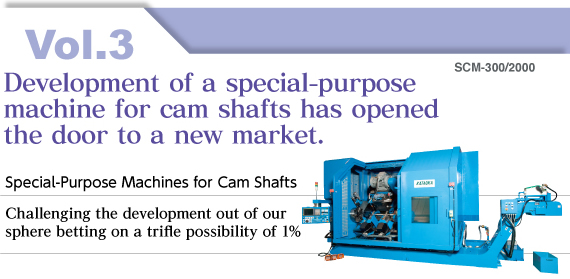

![“Path to the development of CNC machines”[Chapter 1]](img/story_side_bn01.jpg)
![“Path to the development of CNC machines”[Chapter 2]](img/story_side_bn02.jpg)



